Switching off Microchannels Using Surface Acoustic Wave*
2015-11-29ZHANGAnliangZHANGXiaoquanHUwenyanZHANGJianshengFUXiangting
ZHANG Anliang,ZHANG Xiaoquan,HU wenyan,ZHANG Jiansheng,FU Xiangting
(1.School of Electronic Information and Electric Engineering,Changzhou Institute of Technology,Changzhou 213002,China;2.Department of Electrical Engineering,Ningbo University,Ningbo Zhejiang 315211,China)
Switching off Microchannels Using Surface Acoustic Wave*
ZHANG Anliang1*,ZHANG Xiaoquan1,HU wenyan1,ZHANG Jiansheng1,FU Xiangting2
(1.School of Electronic Information and Electric Engineering,Changzhou Institute of Technology,Changzhou 213002,China;2.Department of Electrical Engineering,Ningbo University,Ningbo Zhejiang 315211,China)
For controlling the flow direction of microfluid in microchannels,a new method for switching off microchannels by surface acoustic wave is presented.An interdigital transducer with 27.5 MHz center frequency is fabricated on a 128°yx-LiNbO3piezoelectric substrate for exciting surface acoustic wave.Solid paraffin in poly(dimethylsiloxane)groove is melted by surface acoustic wave and transported along a microchannel due to capillary force.As soon as the electric signal for exciting surface acoustic wave is moved off,the paraffin is solidified and blocked the microchannel.The microchannel is then switched off.Red dye solution is used to demonstrate the operation of switching off the microchannel.Results show that the microchannel can successfully be switched off by surface acoustic wave.Near five minutes switching time is obtained when the electric signal power is 31.7 dBm.The work is help for researchers to study on microvalves controlled by surface acoustic wave.
microfluidic device;switching off microchannel;surface acoustic wave;paraffin;piezoelectric substrate
Miniaturization has become an important research topic in both electronic and non-electronic devices[1],since integrated circuit was invented by Kilby in 1958.Microelectromechanical system(MEMS)is a typical example of miniaturization in non-electronic device[2].During the last two decades,the MEMS have been used for the miniaturization of micro total analysis systems[3].Major advantages of miniaturization are the drastic decrease in chemical reaction time and less consumption of expensive chemical reagents,as well as enhancement of reliability[4-5].Thus,micro total analysis systems(microfluidic devices)have been widely applied in biochemical analysis such as DNA sequencing,protein analysis,single cell analysis,drug screening,and food safety[6-7].These devices generally involve microchannel networks to conduct unit operations such as reagent transportation,mixing,metering,separation,switching,and detection[8].For integrationof these unit operations in a microfluidic substrate,the operations of switching on or off microchannels are necessary,in which microvalves are appropriate candidates.The development of microvalves has rapidly progressed in recent years.They can be roughly categorized as two major categories,namely active microvalves and passive microvalves depending on whether an external power supply is required.Many passive microvalves have been reported in the literature including flap valves,hydrophobic valves,and spherical ball valves.For example,Feng and Kim used Parylene for the valve materials to fabricate a cantilever-type 3μm thick Parylene flap valve[9].Pan used stainless steel balls with a diameter of 0.8 mm to make ball valves[10].Though these passive valves have been incorporated in integrated devices for biochemical analysis,they usually can not be used for sealing or controlling the microfluid in microchannels.
Compared to the passive microvalves,active microvalves have been more widely researched.According to the activating method,there are various active microvalves reported for use in micro total analysis systems,such as pneumatic[11],thermopneumatic[12],electrokinetic[13],electrochemical[14-15],electrostatic[16-17],electromagnetic[18],electrothermal phase change[19-20]or hybrid actuated[21]microvalves.For example,one of the most common active valves in microfluidic systems is a pneumatic valve.When injecting compressed air into the chamber,the resulting deflection of the membranes can work as a valve to stop the flow passing through the microchannel.Ra[22]presented a thermal expansion microvalve of wax.The characteristics of the microvalve were enhanced by improving the mechanical properties of the PDMS membrane by altering prepolymer to cross linker ratio.Phase-change microvalves allow for controlling fluid flow by the phase transition of the valves.The advantage is that they do not require a pneumatic connection to the valve seat.Thus,the microvalves are usually used for microfluidic devices for microfluidic analysis in spit of their slow actuation time.
As an important offset of micro total analysis systems,piezoelectric microfluidic systems[23-25]have been widely researched during recent years.It is reported that microfluidic operations,such as microfluidic generation,transportation,mixing,bio-particles concentration,separation and reaction,have been implemented on piezoelectric devices.The advantages of the piezoelectric microfluidic systems are low cost,simple technology and their driving ability.However,the working fluid on piezoelectric microfluidic device is usually as the form of digital microfluid[26].The evaporation of the digital microfluid will seriously affect the precision of microfluidic analysis.Although digital microfluid encapsulated by oil droplet can solve the problem[27],the generation of oil droplets and the operation of oil encapsulation will increase the analysis time and device size.The form of continuous fluid as working fluid in microchannels on piezoelectric microfluidic device can avoid the evaporation of working fluid.This typically requires switching on or off microchannels to control the operation of the working fluid.However,traditional microvalve mentioned above can not be directly applied in piezoelectric microfluidic devices to switch on or off the microchannels.
Here,we present a new method to switch off microchannels using surface acoustic wave(SAW).A double T type microchannel was used to demonstrate the operation of switching off microchannels.
1 Experimental Section
1.1 Fabrication of a device for switching off microfluidic channels by surface acoustic wave
As parts of the device,microchannels were fabricated using soft lithography technology,and the interdigital transducers were fabricated on a piezoelectric substrate by microelectronic process.The technological process is shown in Fig.1.
In Fig.1,channels for transporting microfluid include channel A,channel B and main channel,which are fabricated using soft lithography technology(Fig.1(a)).The diameter of the circular microchannels A and B is 150μm,andthatofthemainchannelis950μm.A copper sheet with poly(dimethylsiloxane)(PDMS)groove is fixed on the bottom of part of main channel by coating PDMS on their interface and then solidifying in 100℃oven for an hour.The size of the PDMS groove is 5.5 mm length,4 mm width and 2 mm depth.The PDMS groove is connected with the main channel us-ing a hole as shown in(Fig.1(b)).Solid paraffin(China Petroleum&Chemical Corporation,Guangdong)was filled in the PDMS groove(Fig.1(c)).An interdigital transducer was fabricated on 128°yx-LiNbO3substrate using microelectronic technology(Fig.1(d)).A PDMS microgroove and PDMS block were mounted on the piezoelectric substrate(Fig.1(e)).The microgroove is used to accommodate paraffin oil(Tianjin hongyan chemical reagent factory,Tianjin)and PDMS block is used for fixing the channels.The size of the microgroove is 3.5 mm diameter and its depth is 1.0mm.In order to fix the PDMS microgroove and PDMS block onto the piezoelectric substrate,their bottom surface was coated with PDMS and solidified for an hour in 100℃oven.Paraffin oil was filled in the PDMS microgroove(Fig.1(f)).The microchannels with solid paraffin were mounted on the piezoelectric substrate(Fig.1(g)).For heating the solid paraffin in the PDMS groove,the copper sheet should be mounted over the PDMS microgroove with paraffin oil.
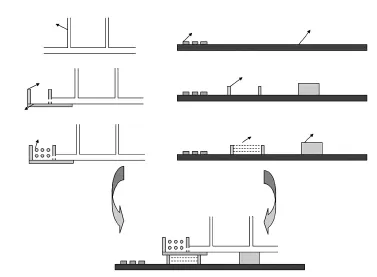
Fig.1 The technological process of the device for switching off double T type microchannels using surface acoustic wave
1.2 Surface acoustic wave principle
Surface acoustic wave(SAW)can be excited when an electrical signal with appropriative frequency is applied to an interdigital transducer(IDT).The amplitude of the surface acoustic wave is affected by the electrical signal power.When the surface acoustic wave meets with liquid on the piezoelectric substrate,the major part of the incident wave energy could radiate into the liquid by Rayleigh angle θR[28]:

Where VWis the velocity of sound propagation in fluids and VRis that on the piezoelectric substrate.
The surface acoustic wave is radiated into the liquid,leading to internal streaming in the liquid,which heats the liquid on the piezoelectric substrate.
1.3 Experimental setup
The experimental setup for switching off microchannels by surface acoustic wave is shown in Fig.2.
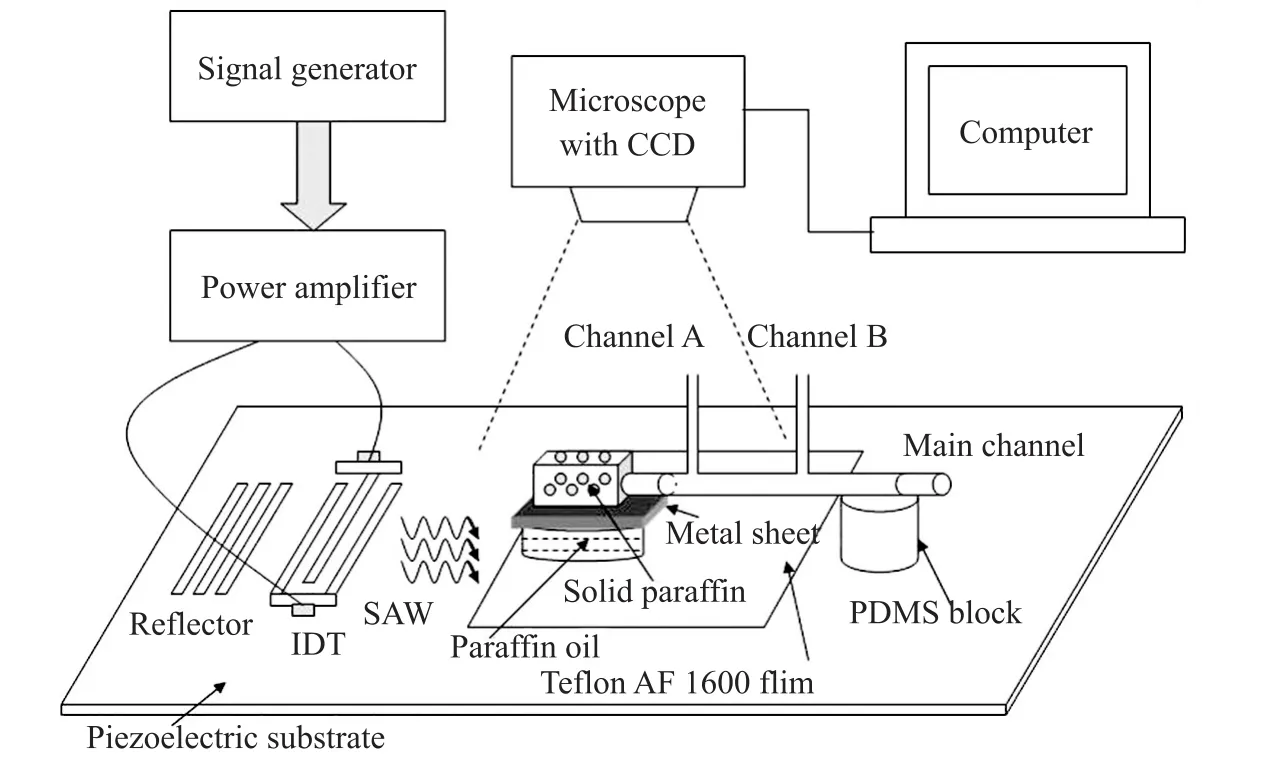
Fig.2 The experimental setup for switching off microchannels by surface acoustic wave
In Fig.2,an interdigital transducer(IDT)and reflector are fabricated on the 128°yx-LiNbO3substrate using microelectric technology.The IDT is with 35 finger pairs,an aperture of 4.32 mm,a period of λ=144μm(the center frequency of the IDT is 27.5 MHz,however its actual center frequency is 26.5 MHz due to the technology error).The areas free ofelectrode on the piezoelectric substrate are coated with Teflon AF 1600(USA,Dupont).The PDMS microgroove filled with paraffin oil is mounted on the piezoelectric substrate.The solid paraffin in the PDMS groove is mounted over the PDMS microgroove.
A RF signal generator(SP1461,EPRE,China)supplies a RF sine signal.The RF sine signal is amplified by a power amplifier(TSA002A,TSH,China)with a gain of 48 dB and maximal unsaturated output power of 30 W.A highly sensitive CCD color video camera(DCE-2,Novel,China)is used to monitor the microfluidic transportation and solid paraffin melting.MDVNT software(Novel,China)is used for camera control and image processing.A power meter(YM2462,Yamei,China)is used to measure the power applied to the IDT.
1.4 The operation of switching off microchannels
An amplified RF signal is applied to the interdigital transducer,leading to the transportation of surface acoustic wave along the substrate surface.As soon as the SAW meets with the paraffin oil in the PDMS microgroove,the temperature of the paraffin oil was raised by the radiation of surface acoustic wave.The solid paraffin in the PDMS groove was heated due to heat transmission till the solid paraffin was melted.At this time,the melted paraffin was transported along the main channel due to capillary force.As soon as the melted paraffin crossed the first T-type channel,RF electric signal was moved off.The melted paraffin was solidified gradually,and then the microchannel was switched off.Fluid could not flow from channel A to channel B at the moment.Fig.3 shows the sketch of the microchannel state.

Fig.3 The sketch of the microchannel state
In Fig.3(a),the microchannnel is in open state,where fluid can be transported from channel A to channel B.As shown in Fig.3(b),the microchannel is in closed state,where fluid can not flow in channels.
2 Results and discussions
In order to switch off the double T type microchannel,solid paraffin should be melted.The relation of solid paraffin melting to the power of the RF electric signal should be experimentally drawn.A high sensitivity thermometer(BK8800,RTX,China)is used to measure the temperature of solid paraffin in PDMS groove.The sampling rate of the thermometer is 2.5/s,and measuring accuracy is 0.1℃.The size of its probe is 0.5 mm diameter.The probe is located in 2.5 mm to the right margin of the PDMS groove.The solid paraffin is filled in the PDMS groove,and its volume is 44 mm3.The thickness of the copper sheet is 0.3 mm,and the distance of the right margin of the copper sheet to that of the PDMS groove is 3 mm.Figure 4 is video snapshots of paraffin melting.
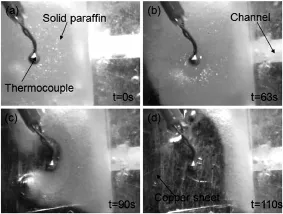
Fig.4 Video snapshots of paraffin melting
In Fig.4,Fig.4(a)shows the state of solid paraffin in the PDMS groove without the radiation of surface acoustic wave.After the radiation of surface acoustic wave,part of the solid paraffin is melted as shown in Fig.4(b).Fig.4(c)~4(d)show the state of the solid paraffin being further melted at 30.8 dBm of the electric signal power.
Using the same method and the same detection position of the probe,the temperature cure of solid paraffin at different electric signal power is shown in Fig.5.
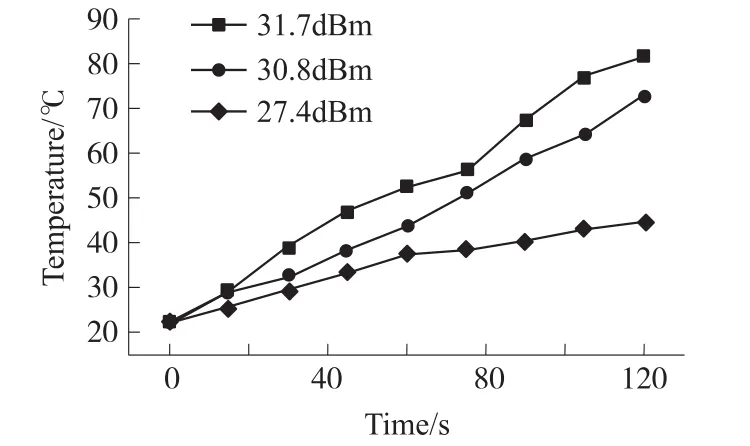
Fig.5 The temperature cure of solid paraffin in the PDMS groove at different electric signal power
According to Fig.5,we can deduce that the temperature variation of paraffin in the PDMS groove is increased with the electric signal power applied to the in-terdigital transducer.We can also observe that the temperature of paraffin is greater than the melting point of the solid paraffin(the melting point of solid paraffin is 53℃~58℃)after 1.5 minutes when the electric signal power is greater than 30.8 dBm,which can be verified in Fig.4.
The volume(V)of PDMS microgroove can be calculated by following formula:

Where r is the radius of circular microgroove and h is its depth.According the formula(2),one can calculate the volume of the microgroove is 9.6 μL.Thus,the 10 μL of paraffin oil in microgroove can ensure effective heat transmission.
The microchannel is normally open state,and microfluid can be transported from channel A to channel B.Fig.6 shows the transportation of red dye solution in channels at 2.5 kPa liquid pressure.

Fig.6 Red dye solution is transported in the microchannel at 2.5 kPa liquid pressures when the microchannel is open state.
In Fig.6,Figs.6(a)and 6(b)show the state of the red dye solution being transported in the channel A.After another 0.6 seconds the red dye solution arrives to the main channel as shown in Fig.6(c).Figs.6(d)to 6(f)show the transportation of red dye solution in the main channel.According to Fig.6(d)and Fig.6(f),the front end of red dye solution is moved 3.66 mm during 4.533 seconds.The liquid velocity is 0.57μL/s.
After the red dye solution in the microchannel has been transported from channel A to channel B,an electric signal was applied to the IDT.When surface acoustic wave is radiated into the paraffin oil for a time,the solid paraffin is melted and transported along the microchannel.The microchannel is switched off as soon as the melted paraffin is solidified.Fig.7 shows the closing operation of the microchannel.
In Fig.7,Fig.7(a)to(d)shows that the solid paraffin in the PDMS groove is gradually melted at 31.7 dBm electric signal power.In order to observe the melting of the paraffin in PDMS groove,Channel A is not in field of view as shown in Figs.7(a)and(b).The melted paraffin is transported in the channel A and main channel as shown in Figs.7(c)to(g).Figs.7(h)and(i)show the melted paraffin in the channels being solidified after the electric signal being moved off.The time for the closing operation of the microchannel is less than five minutes.After the microchannel having been switched off,the red dye solution from the microchannel A will not be transported to channel B due to the block of the solid paraffin.However,the red dye solution can leak along the channels when the liquid press is greater than 200 kPa.Thus,the leakage press of the closed microchannel is 200 kPa.

Fig.7 The closing operation of the microchannel
The advantage of the presented method to switch off microchannels is that it can be easily integrated into a piezoelectric microfluidic device.It will also be helpful to develop a piezoelectric microfluidic device containing microvalves.Then,the evaporation of working fluid on a piezoelectric microfluidic device will be completely solved.
3 Conclusions
Piezoelectric microfluidic device is an important branch of microfluidic systems.The operation of switching on or off microchannels is necessary for microfluidic systems to control the flow of microfluid in microchannels.A new method for switching off microchannels was presented in this work.The technology,principle and operation of switching off microchannels were demonstrated.According to the work,several conclusions can be drawn:(1)Surface acoustic wave can switch off the microchannels on a piezoelectric microfluidic device;(2)Switching time is depended on the electric signal power at the same volume of PDMS microgroove.
[1]冯冲,唐祯安,余隽,等.一种新型MEMS器件中的近场辐射传热现象研究[J].传感技术学报,2013,26(2):170-174.
[2]Kulwant S,Robin J,Soney V,et al.Fabrication of Electron Beam Physical Vapor Deposited Polysilicon Piezoresistive MEMS Pressure Sensor[J].Sensors and Actuators A,2015,223(1):151-158.
[3]Huang C H,Tsou C.The Implementation of a Thermal Bubble Actuated Microfluidic Chip with Microvalve,Micropump and Micromixer[J].SensorsandActuatorsA:Physical,2014,210(1):147-156.
[4]张端,汪甜,高岩,等.高回流被动式微混合器设计及数值模拟[J].传感技术学报,2013,26(11):1621-1626.
[5]纪夏夏,沈丹丹,谭秋林,等.电渗微泵的生理溶液渗透特性研究[J].传感技术学报,2014,27(11):1447-1450.
[6]Mirasoli M,Guardigli M,Michelini E,et al.Recent Advancements in Chemical Luminescence-Based Lab-on-Chip and Microfluidic Platforms for Bioanalysis[J].Journal of Pharmaceutical and Biomedical Analysis,2014,87(1):36-52.
[7]Ghanbari M,Nezhad A S,Agudelo C G,et al.Microfluidic Positioning of Pollen Grains in Lab-on-a-Chip for Single Cell Analysis[J].Journal of Bioscience and Bioengineering,2014,117(4):504-511.
[8]Haeberle S,Zengerle R,Microfluidic Platforms for Lab-on-a-Chip Applications[J].Lab on a Chip,2007,7(9):1094-1110.
[9]Feng G H,Kim E S,Micropump Based on PZT Unimorph and One-Way Parylene Valves[J].Journal of micromechnics and microengineering,2004,14(3):429-435.
[10]Pan T,McDonald S J,Kai E M,et al.A Magnetically Driven PDMS Micropump with Ball Check-Valves[J].Journal of Micromechnics and Microengineering,2005,15(5):1021-1026.
[11]Lisec T,Kreutzer M,Wagner B,A Bistable Pneumatic Microswitch for Driving Fluidic Components[J].Sensors and Actuators A,1996,54(1-3):746-749.
[12]Kim J H,Na K H,Kang C J,et al.A Disposable Thermopneumatic-Actuated Microvalve Stacked with PDMS Layers and ITO-Coated Glass[J].Microelectronic Engineering,2004,73-74(6):864-869.
[13]Kirby B J,Shepodd T J,Hasselbrink E F J,Voltage-Addressable on/off Microvalves for High-Pressure Microchip Separations[J].Journal of Chromatography,2002,979(1-2):147-154.
[14]Aitor E,Luis J F,Kepa M,et al.A Microvalve for Lab-on-a-Chip Applications Based on Electrochemically Actuated SU8 Cantilevers[J].Sensors and Actuators B,2011,155(2):505-511.
[15]Lee D E,Soper S,Wang W,Design and Fabrication of an Electro-Chemically Actuated Microvalve[J].Microsystem Technologies,2008,14:1751-1756.
[16]Yıldırım E,Arıkan M A S,Külah H.A Normally Closed Electrostatic Parylene Microvalve for Micro Total Analysis Systems[J].Sensors and Actuators A,2012,181(6):81-86.
[17]Yoshida K,Tanaka S,Hagihara Y,et al.Normally Closed Electrostatic Microvalve with Pressure Balance Mechanism for Portable Fuel Cell Application[J].Sensors and Actuators A,2010,157(2):290-298.
[18]Luharuka R,LeBlanc S,Bintoro J S.et al.Simulated and Experimental Dynamic Response Characterization of An Electromagnetic Microvalve[J].Sensors and Actuators A,2008,143(2):399-408.
[19]Yang B,Lin Q,A Latchable Microvalve Using Phase Change of Paraffin Wax[J].Sensors and Actuators A,2007,134(1):194-200.
[20]Pal R,Yang M,Johnson B N.et al.Phase Change Microvalve for Integrated Devices[J].Analytical Chemistry,2004,76(13):3740-3748.
[21]Ryu K S,Wang X,Shaikh K,et al.Design And Prototyping of A Surface Micromachined Parylene Microvalve with Hybrid Actuation Scheme:On-chip Thermopneumatic Initiation and Electrostatic Latching[C]//International Conference on Miniaturized System for Chemistry and Life Science,2005,October 9-13,Boston,USA:1192-1194.
[22]Ra G S,Kumar J S,Yoon T S,et al.Improvement of Dynamic Characteristics of Polydimethylsiloxane Based Microvalve[J].Microsystem Technologies 2009,15(4):607-609.
[23]Kim H H,Park D H,Ryu B H,et al.Design and Modeling of Piezoelectric Pump for Microfluid Devices[J].Ferroelectrics,2009,378(1):92-100.
[24]Zhang Z A,Kan J W,Cheng G M,et al.A Piezoelectric Micropump with An Integrated Sensor Based on Space-division Multiplexing[J].Sensors and Actuators A,2013,203(12):29-36.
[25]Antil H,Heinkenschloss M,Hoppe R H W,et al.Reduced Order Modeling Based Shape Optimization of Surface Acoustic Wave Driven Microfluidic Biochips[J].Mathematics and Computers in Simulation,2012,82(10):1986-2003.
[26]Beyssen D,Brizoual L L,Elmazria O,et al.Microfluidic Device Based on Surface Acoustic Wave[J].Sensors and Actuators B,2006,118(1-2):380-385.
[27]Lee C Y,Yu H Y,Pang W,et al.Droplet-based Microreactions with Oil Encapsulation[J].Journal of Microelectronic Systems,2008,17(1):147-156.
[28]Toyokazu U,Takayuki S,Showko S.Investigation of Acoustic Streaming Excited by Surface Acoustic Waves[C]//IEEE Ultrasonics symposium,New York,USA,Nov.7-10:1081-1084(1995).
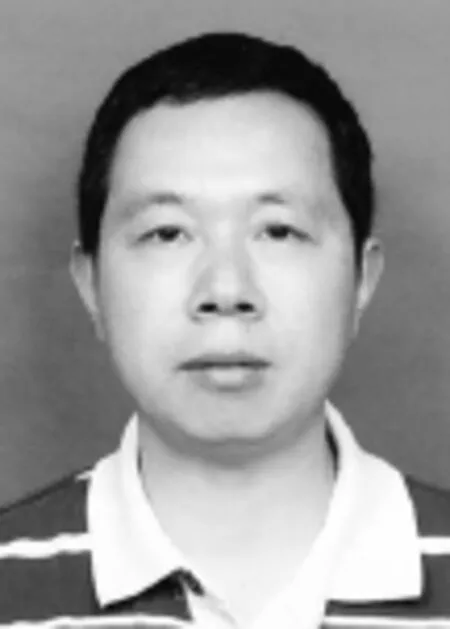
Zhang Anliang(1968-),male,received the Ph.D.degrees in micro-electrics from Zhejiang University,Zhejiang,China,in 2004.He joined Key Laboratory of Analytical Chemistry for Life Science,School of Chemistryand ChemicalEngineering,Nanjing University in 2008 as a post-doctoral fellow.He was an associate professor in the Department of Electric Engineering,Ningbo University.In June 2014,he joined the changzhou Institute of Technology.His scientific interests include surface acoustic waves,lab on a piezoelectric substrate and SAW sensors,zhangal@czu.cn;zhanganliang@nbu.edu.cn.
声表面波为能量源的微通道关闭研究*
章安良1*,张小权1,胡文艳1,张建生1,付相庭2
(1.常州工学院电气学院,江苏常州213002;2.宁波大学电子工程系,浙江宁波315211)
为控制微通道内微流体流向,提出了一种声表面波关闭微通道方法。在128°旋转Y切割X传播方向的LiNbO3压电基片上制作中心频率为27.5 MHz的叉指换能器,其激发的声表面波熔融聚二甲基硅氧烷微槽内固体石蜡,熔融后的石蜡由于毛细作用力沿微通道输运。当移去激发声表面波的电信号后,熔融石蜡固化并阻塞微通道,实现微通道关闭。以红色染料溶液为实验对象,对微通道进行关闭操作。结果表明,声表面波可以成功地实现微通道关闭操作,当电信号功率为31.7 dBm时,微通道关断时间约为5 min。本文工作对声表面波为驱动源的微阀研究具有一定的借鉴意义。
微流器件;关闭微通道;声表面波;石蜡;压电基片
TN722
A
1004-1699(2015)08-1155-06
2015-02-26 修改日期:2015-04-30
��7820
10.3969/j.issn.1004-1699.2015.08.010
项目来源:常州工学院校基金项目(YN1404);常州工学院大学生创新基金项目(J140029);浙江省重点学科项目(Xkl11077)
